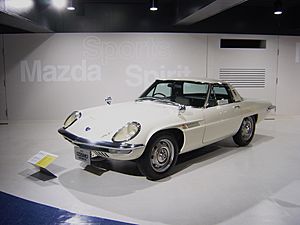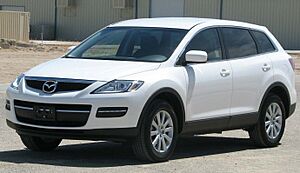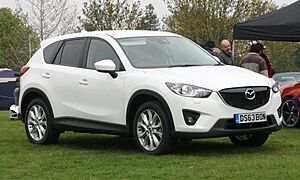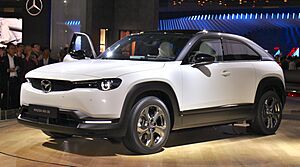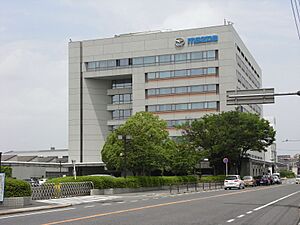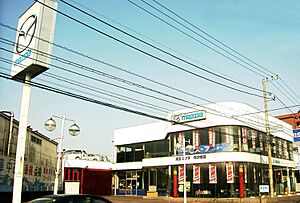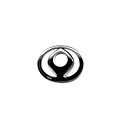Mazda facts for kids
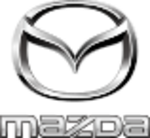
Logo used since 2018
|
|
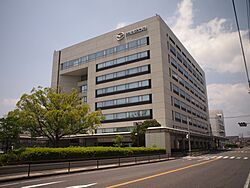
Headquarters in Fuchū, Japan (2020)
|
|
|
Native name
|
マツダ株式会社
|
|---|---|
|
Romanized name
|
Matsuda Kabushiki Gaisha |
| Public | |
| Traded as | TYO: 7261 |
| Industry | Automotive |
| Founded | January 30, 1920 |
| Founder | Jujiro Matsuda |
| Headquarters | 3-1 Shinchi,
Fuchū, Hiroshima Prefecture
,
Japan
|
|
Area served
|
Worldwide |
|
Key people
|
|
| Products | Motor vehicles, engines |
|
Production output
|
|
| Revenue | |
|
Operating income
|
|
| Owners |
|
|
Number of employees
|
48,750 (2022) |
Mazda Motor Corporation (マツダ株式会社, Matsuda Kabushiki gaisha) is a big Japanese company that makes cars. Its main office is in Fuchū, Hiroshima, Japan. The company started on January 30, 1920. It was first called Toyo Cork Kogyo Co., Ltd., and it made cork. Jujiro Matsuda founded the company.
Later, in 1927, the company changed its name to Toyo Kogyo Co., Ltd. It began making vehicles in 1931. Mazda is famous for its new ideas, like the Wankel engine (a special type of engine) and its unique car designs. Mazda has also been involved in car racing for a long time. In 1991, a Mazda car won the famous 24 Hours of Le Mans race.
Mazda has worked with other car companies like Ford and Toyota. In 2023, Mazda made about 1.1 million cars around the world. The name Mazda comes from Ahura Mazda, a god of wisdom and harmony in an old religion called Zoroastrianism. It also comes from the last name of the founder, Matsuda.
Contents
Mazda's Story
How Mazda Started
Mazda started as Toyo Cork Kogyo Co., Ltd. It was a factory that made cork in Hiroshima, Japan, on January 30, 1920. In 1927, the company changed its name to Toyo Kogyo Co., Ltd. In the late 1920s, the company faced money problems. It was saved by the Hiroshima Saving Bank and other business leaders.
In 1931, Toyo Kogyo started making vehicles instead of machine tools. Their first vehicle was the Mazda-Go, a three-wheeled truck. The name Mazda was first used for these trucks. The company chose this name because it sounded like "Ahura Mazda," a god of wisdom. It also honored the founder, Jujiro Matsuda.
During World War II, Toyo Kogyo made weapons for the Japanese military. The company officially became Mazda in 1984. However, all their cars had been called Mazda since the beginning. In 1960, Mazda released its first passenger car, the Mazda R360. This was followed by the Mazda Carol in 1962. These cars were sold at special dealerships called "Mazda Auto Store."
The Wankel Engine
In the 1960s, Mazda decided to focus on a special type of engine called the Wankel rotary engine. This engine is different from regular piston engines. Mazda wanted to stand out from other Japanese car companies. They worked with a German company called NSU.
Mazda launched its first car with a Wankel engine, the Cosmo Sport, in 1967. Mazda became the only car maker to keep using Wankel engines for cars. These rotary engines became popular because they offered good power while being light. This was a big advantage over other cars that needed heavier V6 or V8 engines for the same power.
Mazda started selling its cars in Canada in 1968 and in the United States in 1970. They even made a special Mazda Rotary Pickup truck just for North American buyers. Mazda is the only car company to have ever made a Wankel-powered pickup truck.
However, when the 1973 oil crisis happened, people wanted cars that used less fuel. Wankel engines used more fuel, so they became less popular. Mazda faced big financial problems in 1975. The company was saved by a group of banks and other businesses. Even so, Mazda continued to make cars with regular piston engines, like the smaller Familia and the larger Capella.
Mazda then decided to use the rotary engine for sports cars. They launched the lightweight RX-7 in 1978. This car was very popular. Mazda also created another lightweight sports car, the Mazda MX-5 Miata, in 1989. This car helped bring back the idea of small, fun sports cars.
Working with Ford
From 1974 to 2015, Mazda worked closely with the Ford Motor Company. Ford bought a part of Mazda in 1979 and owned a larger share by 1995. This partnership helped Mazda when it had financial difficulties. Ford gradually sold its shares in Mazda between 2008 and 2015.
The two companies worked on many projects together. For example, Mazda supplied parts to Ford. Mazda's car platforms, like the Familia and Capella, were used for Ford models. In some countries, Ford and Mazda cars were even built in the same factories.
In North America, Mazda built cars for Ford, like the Ford Probe. Ford also helped Mazda by building some Mazda cars in its factories. Mazda even helped Ford develop the 1991 Explorer SUV. Mazda sold its own version called the Mazda Navajo.
Mazda also introduced the first Miller cycle engine in a car, the Millenia luxury sedan, in 1995. This engine was designed to be very efficient.
In the 1990s, Mazda faced more financial problems. Ford increased its ownership to 33.4% in 1996. Henry Wallace became the president of Mazda. He was the first non-Japanese person to lead a Japanese car company. He helped Mazda become profitable again. Mark Fields, another Ford executive, later helped Mazda expand its car lineup.
Mazda and Ford also built a factory together in Thailand called AutoAlliance Thailand. It started making cars in 1998.
In 2008, during a global financial crisis, Ford decided to sell some of its shares in Mazda. This reduced Ford's ownership to 13.4%, meaning Ford no longer controlled Mazda. Mazda bought back some of its shares. In 2010, Ford reduced its stake even further to 3%.
By September 2015, Ford had sold all its remaining shares in Mazda. Even after this, Ford and Mazda continued to work together on some projects and share technology.
Mazda's Recent Efforts
In 2011, Mazda raised money to build a new factory in Salamanca, Mexico. This factory was built with another company called Sumitomo Corporation.
Also in 2011, Mazda introduced its Skyactiv technology. This is a set of new ideas for engines, transmissions, and car bodies. Skyactiv helps cars use less fuel and perform better. Mazda also launched its "Kodo" design language with the Mazda CX-5 in 2011. The CX-5 became Mazda's best-selling car. By March 2022, over 3.5 million CX-5 cars had been sold.
In 2012, Mazda stopped making the Mazda RX-8, which was its last car with a rotary engine. This was due to lower sales and stricter rules about car emissions.
In 2015, Mazda and Toyota agreed to work together. Mazda would share its fuel-efficient Skyactiv engine technology with Toyota. In return, Toyota would share its hydrogen fuel cell systems. In 2017, Toyota bought a small part of Mazda, and Mazda bought a small part of Toyota.
In 2016, Mazda decided to stop making minivans because SUVs became more popular. The production of these minivans ended by early 2018.
Mazda also partnered with Isuzu in 2016 to make pickup trucks. The newest Mazda BT-50 pickup truck, released in 2020, is based on the Isuzu D-Max.
In 2018, Toyota and Mazda announced they would build a factory together in Alabama, USA. This factory, called Mazda Toyota Manufacturing USA, started making cars in 2021. It builds the Toyota Corolla Cross and the Mazda CX-50.
Mazda started making its first electric car, the Mazda MX-30 EV, in May 2020. In November 2020, Mazda showed new inline-six engines that can be used in different ways, including hybrid and electric versions. These engines are used in Mazda's larger cars like the Mazda CX-60 and CX-90.
In April 2024, Mazda introduced the Mazda EZ-6, an electric sedan made with a Chinese company called Changan Automobile. They plan to develop more electric cars together.
Mazda's Brands
In the 1990s, Mazda tried to create different car brands in Japan, like Autozam, Eunos, and ɛ̃fini. Other Japanese car companies like Toyota and Nissan had many different dealerships, so Mazda wanted to do the same.
One special brand was M2. It made very rare versions of cars like the Eunos Roadster. M2 even had its own unique office, but it closed after a short time.
In 1992, Mazda planned a luxury brand called Amati for North America. It was meant to compete with brands like Acura and Lexus. The Amati lineup would have included luxury sedans. However, the Amati brand was canceled before any cars were sold.
In Europe, Mazda used the Xedos name for some models, like the Mazda Xedos 6. These cars were sold under the Mazda brand.
Having so many different brands and models made things difficult for Mazda. It confused customers and stretched the company's design teams. This experiment ended in the mid-1990s because of economic problems in Japan.
Mazda's Leaders
Mazda has always been led by a top executive, usually called the President and CEO. Here are some of the people who have led Mazda:
- Jujiro Matsuda (1920–1951)
- Tsuneji Matsuda (1952–1970)
- Kouhei Matsuda (1970–1977)
- Yoshiki Yamasaki (1977–1984)
- Kenichi Yamamoto (1984–1987)
- Masanori Furuta (1987–1991)
- Yoshihiro Wada (1991–1996)
- Henry Wallace (1996–1997); he was the first non-Japanese CEO of a Japanese car company, appointed by Ford Motor Company.
- James E. Miller (1997–1999)
- Mark Fields (1999–2002)
- Lewis Booth (2002–2003)
- Hisakazu Imaki (2003–2008)
- Takashi Yamanouchi (2008–2013)
- Masamichi Kogai (2013–2018)
- Akira Marumoto (2018–2023)
- Masahiro Moro (since June 2023)
Where Mazda Sells Cars
As of January 2022, the United States is Mazda's biggest market. China and Japan are also very important markets for Mazda. In 2016, Mazda's share of the car market in the U.S. was 1.7 percent. In October 2022, Mazda decided to sell its business in Russia.
Mazda's Green Efforts
Mazda has been researching cars that run on hydrogen for many years. They developed a hybrid minivan called the Mazda Premacy Hydrogen RE Hybrid. This car uses a special rotary engine that can run on either hydrogen or gasoline.
In 2010, Mazda and Toyota agreed to share hybrid technology.
Cars Made from Plants
Mazda is also using materials from plants in its cars. This includes plastics and fabrics made from corn starch. They want to make their cars more environmentally friendly. In 2008, Mazda showed a Mazda5 car with parts made from biomaterials. Up to 30% of the inside parts of the Mazda5 were made from these plant-based materials.
SkyActiv Technology
SkyActiv technology is a special set of ideas Mazda uses in its newer cars. These cars include the Mazda2, Mazda3, Mazda6, and CX-5. SkyActiv helps these cars use less fuel and have better performance.
This technology includes special gasoline engines that squeeze fuel and air very tightly. It also has diesel engines with new turbochargers. SkyActiv also means more efficient automatic and manual transmissions, lighter car bodies, and electric power steering. All these things work together to make Mazda cars more efficient and fun to drive.
Car Racing
Mazda has had great success in car racing with both its Wankel-engine cars and its regular piston-engine cars. Mazda cars and engines compete in many different races around the world. In 1991, Mazda became the first Japanese car maker to win the famous 24 Hours of Le Mans race.
International Races
Mazda's first big race was on October 20, 1968. Two Mazda Cosmo Sport 110S cars entered a very long 84-hour race in Germany. One car finished in fourth place. The next year, Mazda raced Mazda Familia R100 M10A cars. They won the Singapore Grand Prix in April 1969.
The first time a Wankel-engined car won a race in the United States was in 1973. A Mazda RX-2 won an IMSA RS race.
The Mazda RX-7 has won more IMSA races in its class than any other car model. It won its hundredth victory on September 2, 1990. The RX-7 also won its class at the IMSA 24 Hours of Daytona race ten years in a row, starting in 1982.
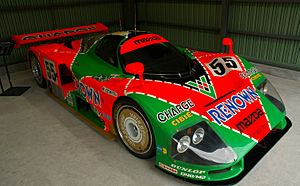
In 1991, a four-rotor Mazda 787B car won the 24 Hours of Le Mans car race. This was a huge win because it was the first time a non-piston-engined car won at Le Mans. Mazda was also the first Japanese brand to win this race overall. After this win, rotary engines were banned from Le Mans for a while, but that rule has since changed.
Mazda cars have also done well in World Land Speed competitions, SCCA races, drag racing, and pro rally competitions.
Special Race Series
The Cooper Tires Atlantic Championship powered by Mazda is a racing series in North America. It uses special race cars with Mazda engines. These cars can go faster than 175 miles per hour.
Formula Mazda is another racing series where cars use Mazda engines. These cars can race on both oval tracks and road courses. The engines are built to be very reliable and last a long time.
Spec Miata is a very popular and affordable road racing class in North America. It uses Mazda Miata cars with limited changes. This makes it a great way for people to get into racing without spending too much money.
Spec RX-7 is also a popular racing class. It uses older Mazda RX-7 cars, which are easy to find and cheap to start racing with.
Sponsorships
Mazda supports many professional sports teams:
- Local Teams:
- Sanfrecce Hiroshima (a soccer team in Japan): Mazda used to own this team directly.
- Hiroshima Toyo Carp (a baseball team in Japan): Mazda has been a part-owner of this team since 1968. The Matsuda family, who founded Mazda, still owns most of the team.
- Teams Around the World:
- North Melbourne Football Club (Australia)
- AS Roma (Italy)
- ACF Fiorentina (Italy)
- SK Sigma Olomouc (Czech Republic)
- Nakhon Ratchasima (Thailand)
Mazda also sponsors many marathon and relay race events in Japan. They support other sports and charity events in Hiroshima.
From 2001 to 2018, Mazda sponsored the Laguna Seca racing track in California. They used it for car testing and many racing events.
Marketing and Slogans
Mazda has used many different advertising slogans over the years. Some old ones include: "The more you look, the more you like" and "It Just Feels Right."
Since 2000, Mazda has used the famous phrase "Zoom-Zoom." This slogan describes the feeling of excitement and motion that Mazda says its cars have. The "Zoom-Zoom" campaign has been very successful and is used all over the world.
Many TV and radio ads for "Zoom-Zoom" have a special song. Early ads also featured a young boy whispering the "Zoom-Zoom" tagline.
In 2015, Mazda launched a new campaign called "Driving Matters." This slogan was meant to strengthen the "Zoom-Zoom" idea. It focused on how important driving is to people.
Sales and Production
| Year | Production | Sales | ||||
|---|---|---|---|---|---|---|
| Japan | Outside Japan | Total | Japan | U.S. | Global | |
| 2006 | 966,547 | 318,773 | 1,285,320 | 270,241 | 268,786 | |
| 2007 | 995,511 | 291,297 | 1,286,808 | 254,136 | 296,110 | |
| 2008 | 1,078,690 | 270,584 | 1,349,274 | 244,624 | 263,849 | |
| 2009 | 717,175 | 266,692 | 983,867 | 204,372 | 207,677 | |
| 2010 | 912,836 | 394,704 | 1,307,540 | 223,861 | 229,576 | |
| 2011 | 813,302 | 352,289 | 1,165,591 | 189,990 | 250,426 | |
| 2012 | 845,550 | 343,733 | 1,189,283 | 218,359 | 302,701 | |
| 2013 | 966,628 | 297,545 | 1,264,173 | 228,256 | 283,945 | |
| 2014 | 934,300 | 394,126 | 1,328,426 | 224,372 | 305,801 | |
| 2015 | 972,237 | 568,339 | 1,540,576 | 245,487 | 319,185 | |
| 2016 | 977,376 | 608,637 | 1,586,013 | 201,370 | 297,315 | |
| 2017 | 971,455 | 636,147 | 1,607,602 | 209,660 | 289,469 | |
| 2018 | 996,264 | 600,503 | 1,596,767 | 220,734 | 300,325 | |
| 2019 | 1,010,275 | 477,642 | 1,487,917 | 203,576 | 278,550 | 1,497,823 |
| 2020 | 747,033 | 428,106 | 1,175,139 | 177,043 | 279,076 | 1,243,005 |
| 2021 | 735,649 | 339,338 | 1,074,987 | 157,261 | 328,237 | 1,287,548 |
| 2022 | 734,833 | 357,063 | 1,091,896 | 161,278 | 294,909 | 1,116,107 |
| 2023 | 839,170 | 414,484 | 1,253,654 | 177,788 | 365,044 | 1,244,613 |
| 2024 | 749,428 | 451,621 | 1,201,049 | 141,946 | 424,382 | 1,277,578 |
Images for kids
-
Shortly after the release of the new symbol, the design was smoothed out to reduce its similarity to Renault's. This is sometimes referred to as the "eternal flame" logo. It also represented the design of the rotary engine that Mazda was famous for.
See also
 In Spanish: Mazda para niños
In Spanish: Mazda para niños


